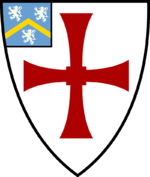Durham University Department of Physics
 | |
Academic staff | 47 |
|---|---|
| Postgraduates | 90 |
| 50 | |
| Location | Durham, County Durham, England |
| Campus | Science Site, Durham University |
| Website | www.dur.ac.uk/physics |
The Department of Physics at Durham University in Durham, England, is a large physics and astronomy department involved in both undergraduate teaching and scientific research. In the most recent subject review report by the Quality Assurance Agency (QAA) for Higher Education, the Department achieved maximum marks (24/24)[1] and in the 2001 Research Assessment Exercise the Department retained a Grade 5A rating.[2] In addition, the Department's research into Space Science and Astrophysics was rated as number one in Europe and fourth in the world by Thomson Reuters from its Essential Science Indicators (1998–2008). [3]
Location and admissions
The Department is situated on the University's Science Site, on the south side of the city of Durham, 2 miles from Junction 62 of the A1(M) and approx 5 minutes drive from Durham Station.[4] Students are members of one of the 14 colleges in the city.
Each year the Department admits around 140 students for degrees in Physics, Physics & Astronomy and Theoretical Physics. The current standard conditional offer given to a student taking A-Level examinations is A*A*A, to include Physics and Mathematics.[5]
Admissions are processed through UCAS. In addition, an applicant must be accepted by one of the colleges of Durham University.[6]
Taught programmes
The Department offers 3 year (Bachelor's) Undergraduate courses in Physics and Physics & Astronomy, 4 year (Master's) courses in Physics, Physics & Astronomy and Theoretical Physics and also participates in Joint Honours and Natural Science programmes with other departments of the university. Taught and research based Master's degrees and research based PhDs are available at Postgraduate level.[7]
All research takes place within the department whilst teaching also takes place in various locations around the University.
Notable staff
The Departments staff includes 24 professors, 6 readers, 8 senior lecturers, 9 lecturers, about 50 post-doctoral researchers and fellows and 90 PhD postgraduate students.[8][9] These include:
- Simon Morris, Head of Department
- David Flower, Atomic and Molecular Physics
- Richard Keith Ellis FRS, Director of the IPPP
- Nigel Glover FRS, Professor of Physics
- Carlos Frenk FRS, Ogden Professor of Fundamental Physics
- Tom McLeish FRS, Professor of Physics
Research groups
The Department maintains five research groups:
- Advanced Instrumentation
- Astronomy and Astrophysics
- Atomic and Molecular Physics
- Condensed Matter Physics
- Elementary Particle Theory
In addition the Department is involved with the Institute for Computational Cosmology, the Institute for Particle Physics Phenomenology, the Photonic Materials Institute, the Centre for Renewable Energy and the Biophysical Sciences Institute.[10]
PhysSoc
The Durham University Physics Society (PhysSoc) is mostly made up of Physics Undergraduates from the Department but is open to a wider audience, aiming to "bring together undergraduates with an interest in Physics, with an aim to further their understanding and interest in the most fundamental science." It runs a regular series of lectures and socials as well as hosting visits to national and international Physics facilities such as JET and CERN.
References
- ↑ QAA - Report on University of Durham, Physics and Astronomy, QAA, UK. Retrieved 1/10/09.
- ↑ Research Assessment Exercise, UK. Retrieved 1/10/09.
- ↑ "Institutional rankings in space sciences". Times Higher Education Supplement. Retrieved 2009-01-31.
- ↑ Durham University Physics Department - Location, Durham University, UK. Retrieved 1/10/09.
- ↑ Durham University Department of Physics - Undergraduate Courses, Durham University, UK. Retrieved on 4 November 2015.
- ↑ Durham University Department of Physics - How to apply, Durham University, UK. Retrieved on 1 September 2009.
- ↑ Durham University Physics Department - Courses, Durham University, UK. Retrieved 1/10/09.
- ↑ Durham University Physics Department - About, Durham University, UK. Retrieved 1/10/09.
- ↑ Durham University Physics Department - Staff, Durham University, UK. Retrieved 1/10/09.
- ↑ Durham University Physics Department - Research, Durham University, UK. Retrieved 1/10/09.
